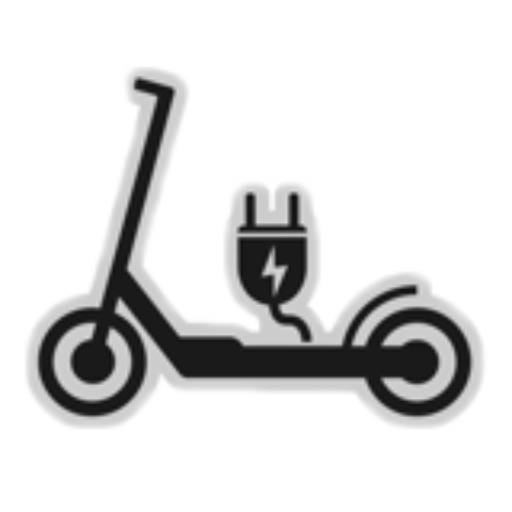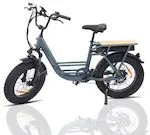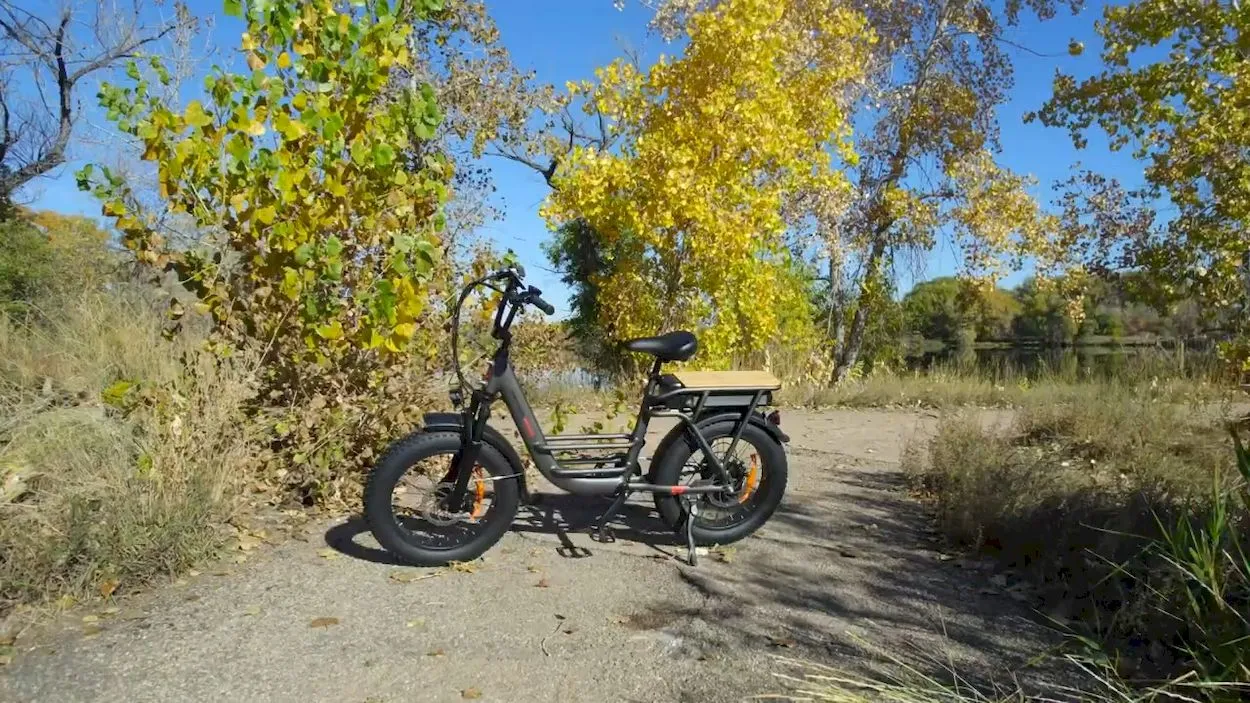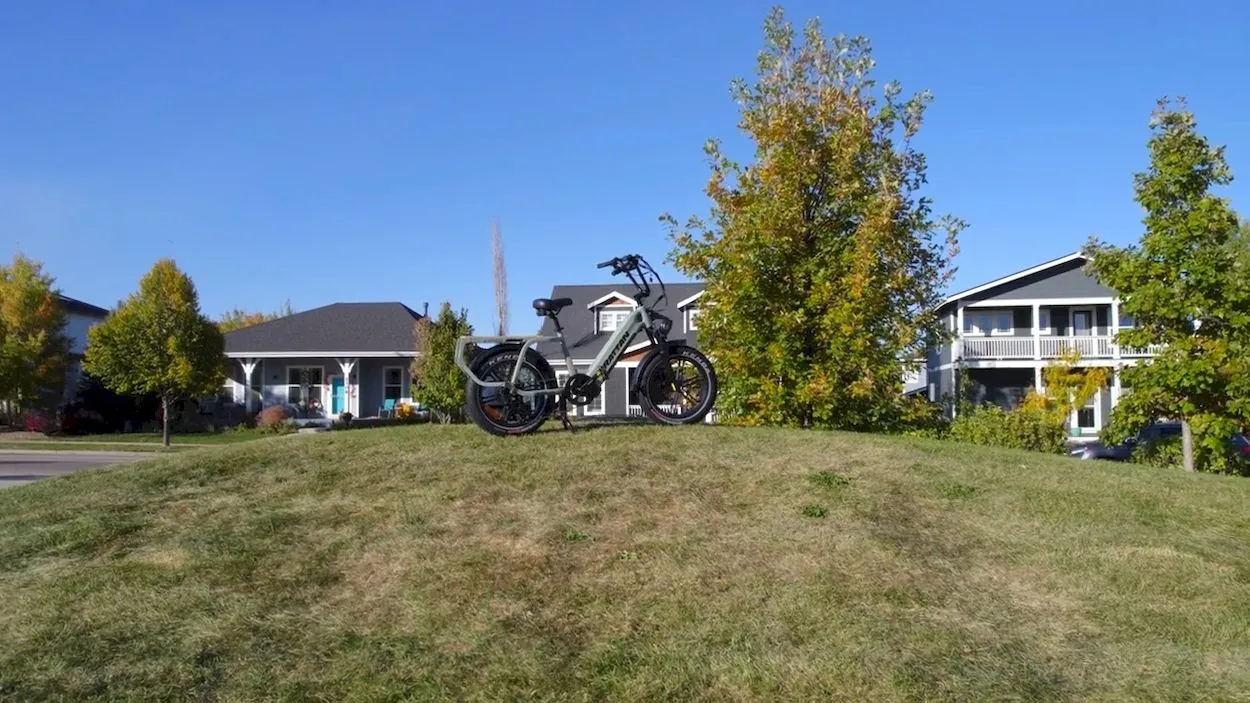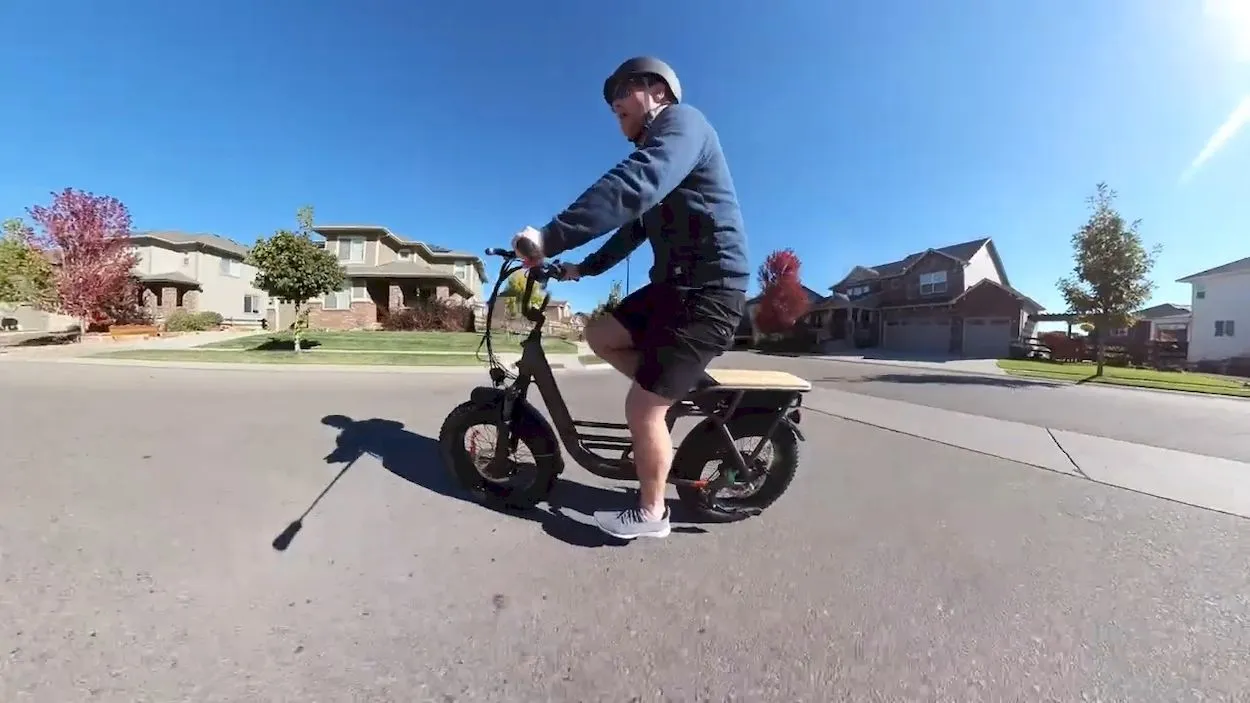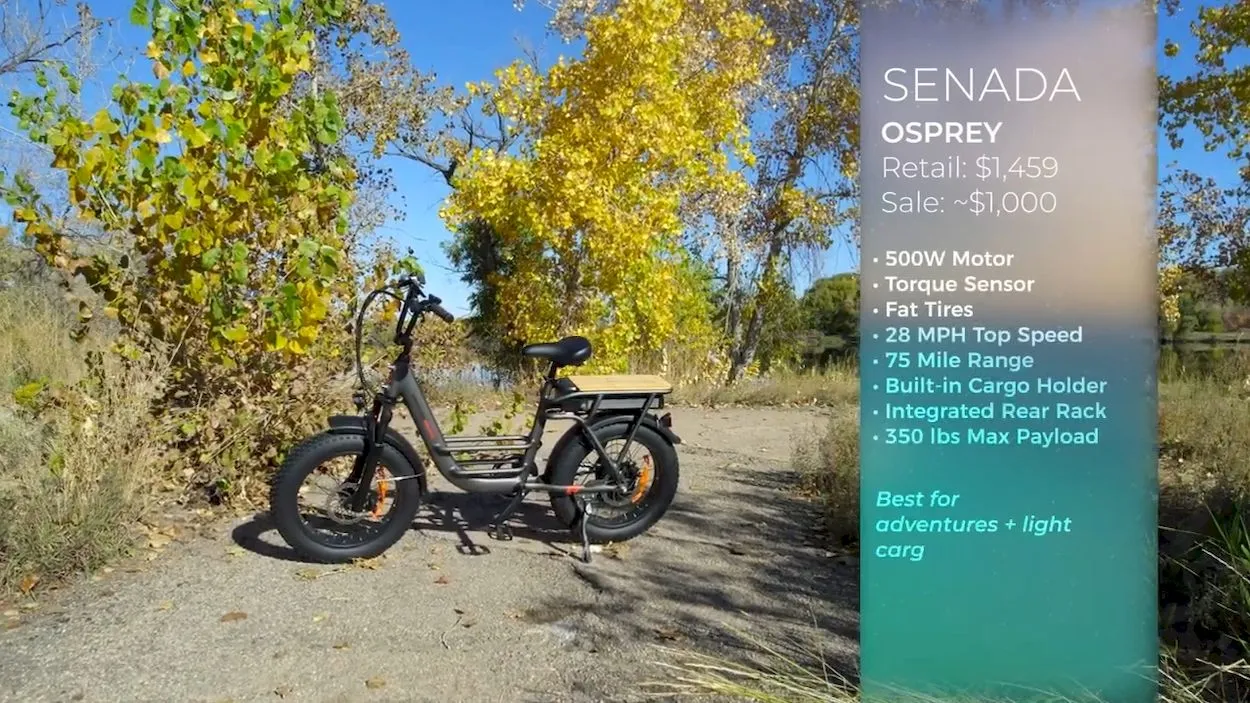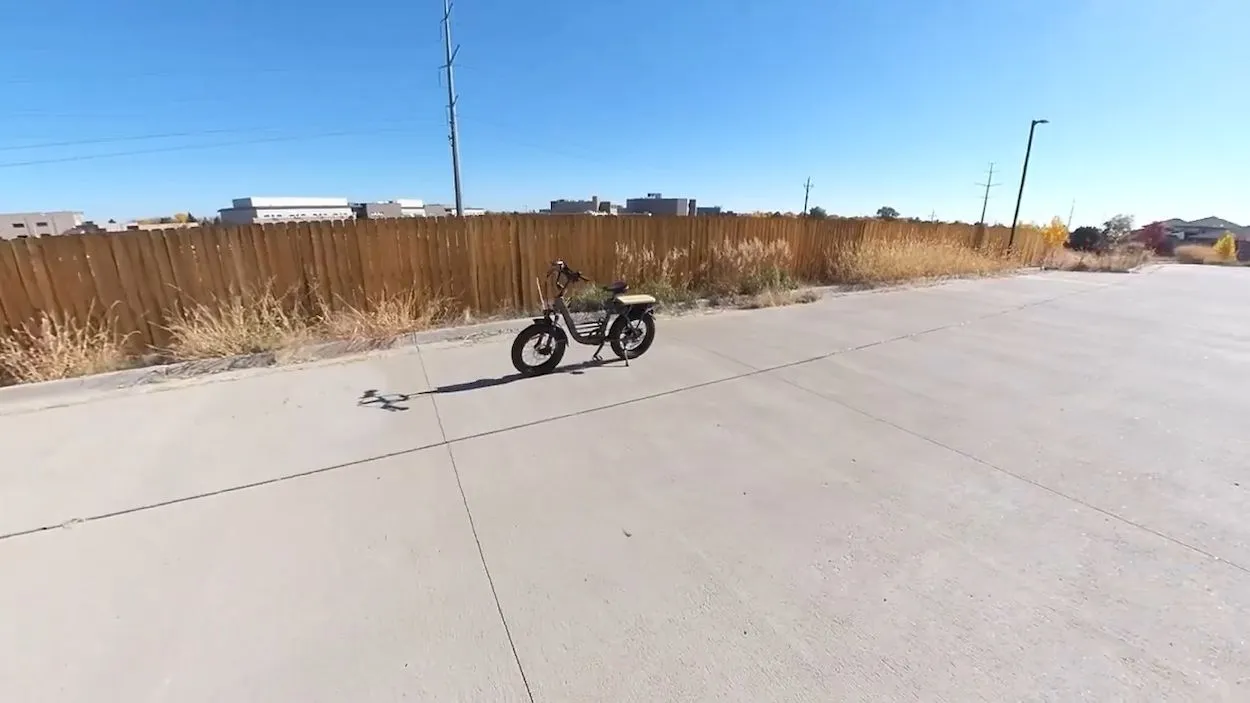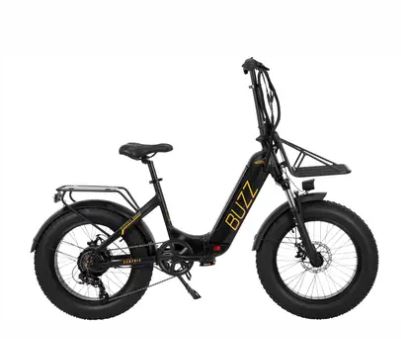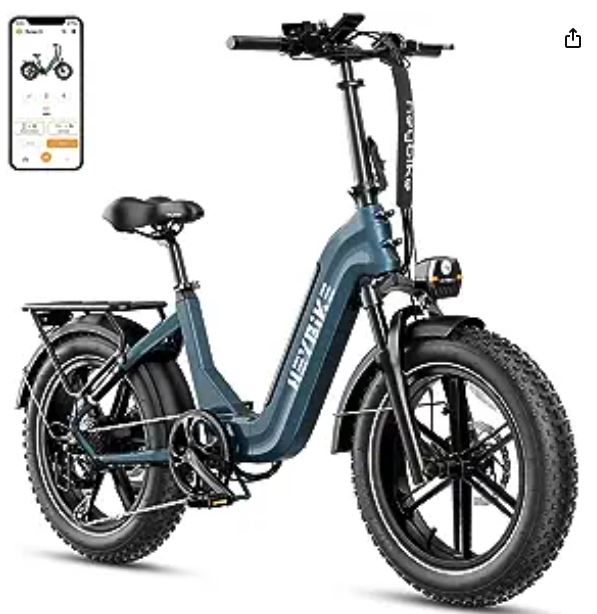Alright, let’s dive into the Senada Osprey electric bike. It’s fascinating how trends in bikes, like in many aspects of life, tend to ebb and flow. Senada Osprey had the chance to test this bike alongside another from Ratan. Now, the Ratan Quiser shares a striking resemblance to the Senada Osprey, but there are some key differences worth exploring.
First and foremost, let’s talk price. The Senada Osprey is currently on sale for $999, a significant markdown from its regular retail price, which hovers around $1,500. This price drop is certainly noteworthy and makes the Osprey an enticing option for budget-conscious buyers.
But what sets the Senada Osprey apart from its Ratan counterpart? Well, for one, its design and features offer a unique appeal. From its sleek frame to its sturdy tires, the Osprey exudes a sense of reliability and style. However, beyond the aesthetics, there are functional differences worth noting.
| Frame Material | Aluminum |
| Motor | 500 watt |
| Derailleur | 7 speed gears |
| Shock absorption | Shock absorber fork |
| Size Guide | 20" x 4" Cargo |
| Battery | 48 volt 20 amp-hour li-ion battery |
| Range | 40~75 miles (64~120 km) |
| Maximum Weight Recommendation | 352.74 Pounds |
| Recommended Rider Height | 5'2" ~ 6'2" (160cm ~ 190cm) |
Osprey vs. Rattan
In the Osprey model, there is a convenient cargo spot integrated into the design. This spot provides a practical space for storing essentials during rides, making it convenient for users. Additionally, the battery is located at the back of the bike, which allows for easy access and removal. This design choice also helps distribute the weight more evenly, lowering the center of gravity and potentially enhancing stability, especially considering the bike’s fat tire design.
Conversely, in the Rattan electric bike, the battery is not as conveniently located. It may not be as easily accessible or removable compared to the Osprey model. However, the exact placement and accessibility of the battery in the Rattan model are not explicitly mentioned in the provided text, so further comparison based on this aspect may require additional information.
Aside from the differences in cargo spot design and battery placement, other notable features of the Osprey electric bike include its impressive display, featuring a unique startup sequence, a powerful 500 watt motor, and its classification as a class 3 ebike, allowing speeds of up to 28 mph. Additionally, the Osprey offers torque sensing pedal assist, enhancing the overall riding experience by providing intuitive support based on the rider’s pedal input.
Torque Sensors
Senada Osprey is a cycling enthusiast who has delved deep into the intricacies of bike technology, particularly focusing on torque and cadence sensors. These sensors play a crucial role in the performance and feel of electric bikes, offering riders different experiences based on their preferences and riding styles.
Torque and cadence sensors fundamentally alter how power is delivered from the rider to the bike’s motor. Cadence sensors, as Osprey explains, measure the speed at which the rider pedals. They detect the frequency of pedal rotations, with more rotations translating to more power delivered to the wheels. This system provides a linear increase in power output as the rider pedals faster, regardless of the gear they are in. However, some cyclists find that cadence sensors can feel less natural due to the potential for inaccuracies, often caused by the magnets integrated into the sensors.
On the other hand, torque sensors, according to Osprey’s expertise, gauge the force applied by the rider to the pedals. These sensors measure the actual pressure exerted by the rider’s legs, delivering power in proportion to this force. Therefore, the more force a rider applies, the more power is transferred to the motor. Unlike cadence sensors, torque sensors aim to match the rider’s effort more precisely, resulting in a smoother and more intuitive riding experience.
Osprey appreciates the predictability and safety offered by torque sensors. It notes that while the sudden bursts of power generated by cadence sensors can be exhilarating, they can also be less reliable and potentially unsafe, especially in certain riding conditions.
Motor and Driving Test
Senada, an avid cyclist with a discerning eye for bike technology, recently took a new bike out for a spin and shared her initial impressions. While overall satisfied with the bike’s performance, it noted one particular aspect that stood out as a minor drawback: the mechanical disc brakes.
As Osprey explains, the bike’s mechanical disc brakes are not a deal-breaker by any means, nor are they a significant issue. However, having become accustomed to the superior performance of hydraulic disc brakes, the mechanical brakes on this particular bike fell short of her expectations. It describes the difference in braking feel between hydraulic and mechanical systems, expressing a preference for the former due to its smoother and more responsive operation.
Despite this one drawback, Osprey acknowledges that compromises often need to be made to keep the cost of a bike down, and opting for mechanical disc brakes was likely a strategic choice to achieve this. It understands the necessity of saving costs in certain areas while still delivering a quality product overall.
Additionally, Osprey comments on the bike’s 500W motor, which it initially perceived as less powerful compared to some other models it’s tested with 750W motors. However, upon riding the bike, it found the motor to be plenty peppy, indicating that it delivers a satisfying level of assistance during her ride. It speculates that the motor might be tuned differently to provide a more efficient power delivery, resulting in a lively riding experience despite the lower wattage.
Senada Osprey, with her keen eye for detail and passion for cycling, recently took a new electric bike out for a thorough test ride. Her comprehensive evaluation covered various aspects of the bike’s performance, highlighting both its strengths and areas for improvement.
To kick off her assessment, Osprey conducted a speed test, putting the bike through its paces to gauge its acceleration and top speed capabilities. It noted that despite the bike featuring a 500W motor and weighing approximately 188.5 lbs, it exhibited impressive pep, reaching speeds of up to 28 miles per hour. This performance exceeded her expectations, demonstrating the bike’s efficient power delivery and responsiveness.
Next, Osprey tested the bike’s braking system, which features mechanical disc brakes rather than hydraulic ones. While acknowledging the difference in feel compared to hydraulic brakes, it found the mechanical brakes to be effective, bringing the bike to a halt smoothly and without any skidding. Despite her preference for hydraulic brakes, Osprey appreciated the mechanical brakes’ added stopping power.
One aspect that particularly impressed Osprey was the bike’s agility and responsiveness during hill climbs. It described the bike as “zippy” and praised its ability to tackle inclines with ease. Additionally, it noted the smooth operation of the bike’s gears, ensuring a seamless transition between different riding conditions.
Osprey also highlighted the bike’s torque sensor, which it found to deliver power in a more natural and intuitive manner compared to cadence sensors. It demonstrated how the torque sensor seamlessly matched her pedaling effort, providing a smooth and consistent riding experience.
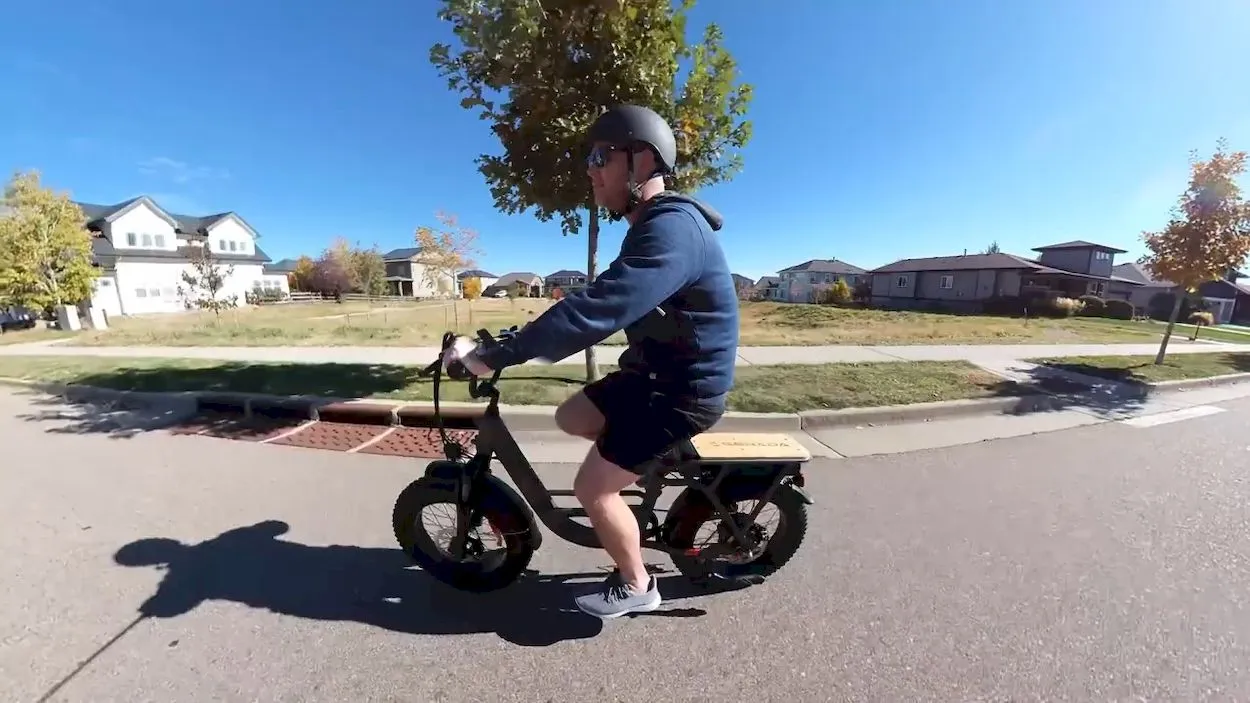
Despite its impressive performance, Osprey identified a few minor drawbacks of the bike, such as non-adjustable handlebars and the presence of some gear issues that needed tuning. However, it emphasized that these issues were relatively minor and could be easily addressed.
In terms of its target audience, Osprey suggested that the bike would be well-suited for commuters or recreational riders looking for a reliable and affordable electric bike. While not designed for serious off-roading, the bike’s front suspension and fat tires make it capable of handling moderate trails and rough terrain with ease.
So, Osprey concluded that the bike offered excellent value for its price point, delivering a satisfying riding experience with its combination of power, agility, and comfort. Her insightful evaluation provides valuable insights for prospective buyers seeking an electric bike that balances performance, affordability, and versatility.
Senada Osprey: Conclusions
Overall, Senada Osprey’s thorough evaluation of the electric bike it tested revealed some surprising findings and important considerations for prospective buyers.
One notable discovery was the unexpected performance of the 500W motor compared to a 750W motor. Despite the lower wattage, Osprey found the bike to feel peppier, indicating that factors such as tuning or torque output may have contributed to its lively ride. This revelation underscores the importance of considering not just the motor’s wattage, but also its overall efficiency and power delivery.
Moreover, Osprey emphasized the compelling value proposition of the bike, especially when compared to higher-priced alternatives. It expressed gratitude for testing the bikes in the order it did, as it allowed her to appreciate the strengths of the second bike more fully. This insight highlights the importance of exploring different options and comparing them directly to make informed purchasing decisions.
In terms of suitability, Osprey suggested that the bike is best suited for individuals seeking a reliable and affordable option for casual riding or commuting. Its versatility and capability to carry light cargo make it an attractive choice for daily transportation needs.
As Osprey wraps up her evaluation, it extends an invitation for further discussion and inquiries from her audience. Her willingness to engage with viewers and address their questions reflects her commitment to providing valuable insights and guidance in the realm of electric bikes.
So, Osprey’s review offers valuable insights and considerations for those in the market for an electric bike, highlighting the importance of performance, value, and suitability for individual needs.
